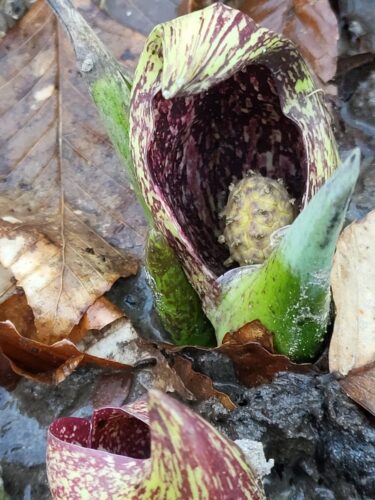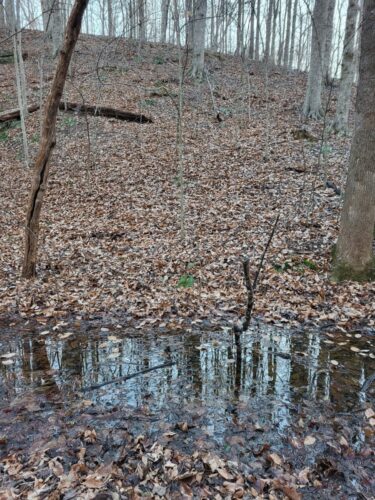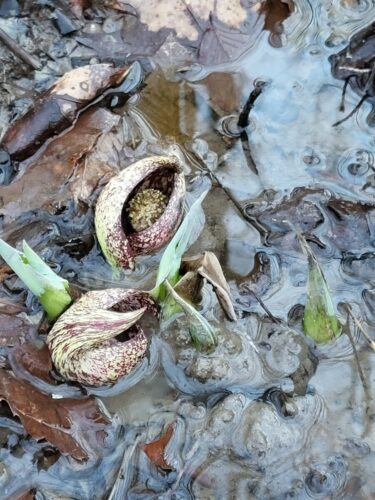The Smell of Spring?
February 17, 2023 3:32 pm
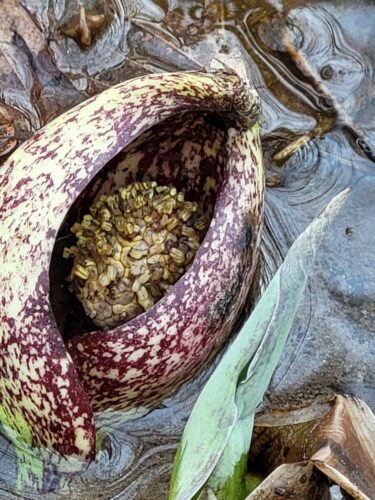
By Ellen Powell, DOF Conservation Education Coordinator
I’m on a mission to teach you that plants are cool. They may look like they’re just sitting there, but they’re hiding superpowers. Watch this blog in 2023 for more posts about amazing Virginia plants!
In the dead of winter, from the muck of a woodland seep, rises a hooded figure of mottled purple, the color of dead flesh. Undeterred by snow and ice, this strange organism begins to generate its own heat, warming the surrounding area as much as 20 degrees. It opens its hood to release the aroma of rotting meat, revealing a bulbous, bumpy stalk that’s downright alien.
This weird plant is skunk cabbage, Symplocarpus foetidus, and it could have grown right out of a science fiction novel. Its botanical name loosely translates to “stinky connected fruit.” The flowers (and later fruit) are tightly clustered on a spike called a spadix, surrounded by a hood called a spathe. Feel free to throw those terms around and impress your friends.
- Good view of spadix
- Flowers in bloom
The unappetizing smell of skunk cabbage lures some very specific pollinators: flies, gnats, and even carrion beetles. These insects take advantage of sunlit winter days to seek out the decaying animals on which they feed. Skunk cabbage’s odor mimics that smell, for a bit of botanical trickery that works to the plant’s advantage.
Skunk cabbage is one of the first native wildflowers to bloom. The flower emerges first, in early to mid-February, with basal leaves that arise later. At first rolled, they unfold into large, vivid green leaves that glow like fluorescent beacons from the forest floor. A disclaimer here: DO NOT PICK AND EAT THIS CABBAGE! The leaves contain calcium oxalate crystals, which are essentially tiny sharp crystals that lacerate and irritate the tongue and mouth, causing severe pain and swelling.
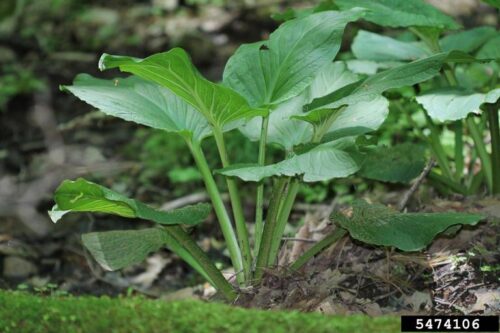
Skunk cabbage leaves; photo credit Rob Routledge, Sault College, Bugwood.org
I recently joined Mary Lee Epps, Master Naturalist and botanist extraordinaire, to photograph skunk cabbage in her woods. We kept a lookout for spathes while wading through several inches of water at the base of a steep slope. The blooms were well camouflaged in the leaf litter, but we found quite a few beginning to open. I didn’t smell the characteristic odor, but if I’d gotten that close to them I likely would have gotten wet, making for a miserable trek back up to the house. The day was extremely cold and windy, so that may have affected the amount of scent.
- This saturated area at the base of a woodland slope is perfect skunk cabbage habitat.
- Blooms and emerging leaves
To see skunk cabbage in bloom, put on some rubber boots and head to an area where groundwater saturates the surface. Go now, because in a few weeks, the leaves will begin to emerge, obscuring the withering spadix. As with many spring ephemeral wildflowers, skunk cabbage emerges early so that it can take advantage of unfiltered sunlight through the bare trees. By summer, even the leaves will have disappeared. But the roots of the mother plant will lie in wait, ready to perform again an eerie ritual to summon spring.
Tags: Spring, Woodland Plants
Category: Education

